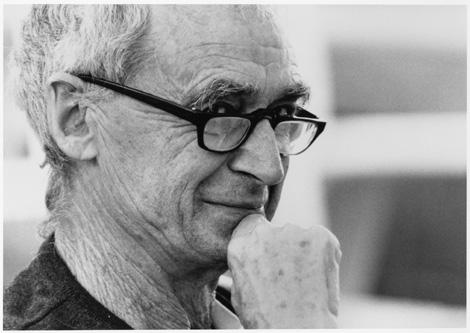
New Leader for Paolo Soleri’s Cosanti Foundation
Cosanti Foundation, whose principal project is Arcosanti, architect Paolo Soleri’s mesa-top urban laboratory in Paradise Valley, AZ, has chosen Jeff Stein as president to succeed its nonagenarian founder.
Soleri, 92, had been looking for two years to retire, prompting the board through the uneasy process of appointing a successor.

Paolo Soleri
Stein, who departs his former job as Dean of the Boston Architectural College to assume the position, brings a deep history with Cosanti, beginning with a 1975 workshop he delivered there, and a subsequent seven years on the staff working on exhibition design and publications. Stein’s 35-year association with Soleri and his long relationship with key Cosanti staff will facilitate his integration both philosophically and administratively with the organization.
Stein, in an interview from Boston, said he feels that Soleri’s writings, drawings, models, windbell production, building workshops and architecture have, over 50 years, established a clear course for him to extend into new possibilities and partnerships, as the foundation’s new leader.
Cosanti as a name, states Stein, amalgamates two Italian words, Cosa-anti, meaning “before-things”: a philosophy.
Soleri’s philosophy, Arcology, proposes the concentration of intensive human activities that integrate work, dwelling and play in modular cities, adapted to climate. These modular cities conserve energy and land, and reflect “elegant frugality”- delivering more value than cost. Stein anticipates propagating Cosanti ideas along established paths; and testing the Arcology concept through built works, education and workshops, as well as further publication, exhibitions and partnerships. Soleri himself will remain a presence although will be reducing his day-to-day role to focus on ecumenical studies.

Arcosanti
Arcosanti – the physical destination – stands as the principal platform for a visitor exploring Arcology (a neologism uniting “architecture” and “ecology,” about which critic Ada Louise Huxtable wrote, “are two parts of the same thing, inseparable in their effect on man.”
Limning a rimrock edge an hour’s drive north of Phoenix, Arcosanti is a “company town” where a population of about 85, augmented by a flow of workshop participants, (8000 to date), discuss, implement and test Soleri’s ideas. Visiting this urban prototype, it’s pretty clear that “elegant frugality” does not imply puritanism. South-oriented siting recalls early Native American settlements at Tsankawi or Bandelier in New Mexico’s Jemez Mountains , where troglodytic dwellings face the sun.
The architectural archipelago at Arcosanti conveys a sense of life’s easy celebration. Incorporating spaces of differing scales with modulating degrees of openness to a circulating network, the architecture is a union of structure and paths, parks, passages, as well as useable roofs and stairways. Many exploit the passive-solar strategy of accumulating warmth in winter and shading in summer. Communal, entertainment and productive functions of the architecture intersperse with or adjoin dwellings. Openness and connectedness intertwine. Arcosanti’s three-dimensional buildings represent a performative integration of human life’s diurnal animations. A road ringing the mesatop and curling to the valley below permits services to plug in to this idealistic architectural campus. But Arcosanti’s core circulation is mainly pedestrian, freeing residents and visitors to experience the space as architectural, landscaped, and “natural”.
Cosanti’s entire program is educational. As dean of Boston Architectural College Stein said he has perceived “a hunger among the new generation of design students to make something useful, lasting, to undertake work that is of real value to the culture”. (Below: A video in which he announces a solar competition for students.)
In the face of the rising cost of fuels for cars and trucks, and the diminishing value of extended suburban housing, Stein sees the market tilting in favor of Cosanti’s compact modular urban schema.Having for 50 years tested and developed urban modes and building forms that address this impulse, Cosanti is positioned to offer a developed lean alternative to today’s pervasive militarized architecture and planning, and the alienated zoning that excludes work from play from dwelling; and has made sprawling corporate barracks and distant suburbs an impediment to urban membership.
Exhibitions powered by Soleri’s visualizations and Cosanti’s model-making skills have long been essential to publicizing Arcology. In 1970 Soleri changed the American architectural and urbanist conversation with a massive show of models and drawings that opened at the Corcoran Gallery in Washington, D.C. and the simultaneous publication of his book Arcology: The City in the Image of Man. In 2009, most recently, a 38- foot maquette of Solare, Arcosanti’s model linear city of layered amenities, energy production, agriculture and transport, was well-received at the Beijing Center for the Arts. One of Stein’s challenges will be to continue Cosanti’s virtuoso presentation.
Finally, Stein envisions future alliances between Cosanti and partner organizations. “Cosanti is a place for ideas, a place to think things through…To develop these ideas on the ground requires partners in other areas: finance, construction management, material science, etc. It is our belief that, by participating with us in Arcosanti’s construction, the benefits to potential partners would be enormous.”
Partnerships may operate in a reverse direction too, with Arcology informing development of urban design as an alternative to inefficient sprawl.
